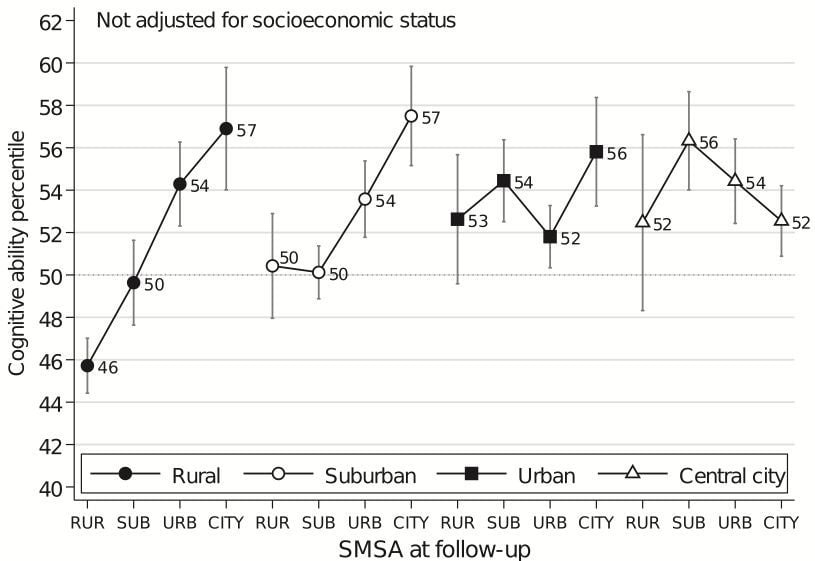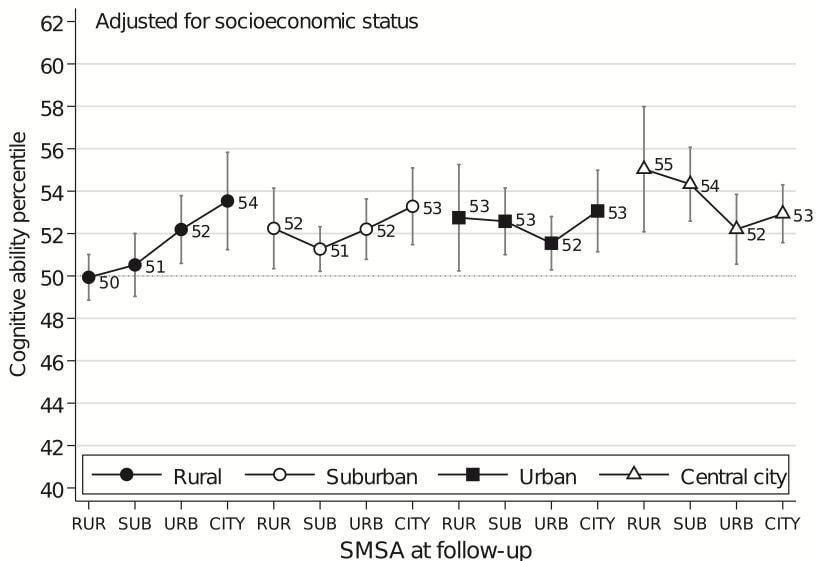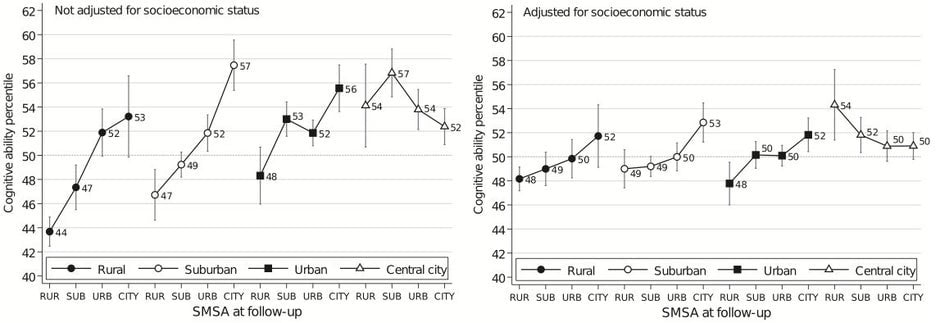Those with the highest IQs grow up in the country and move to the city
There are obvious economic reasons why people move some places and not others: Maybe they want a higher-paying job, or maybe a lower rent or mortgage. There might be personality factors involved, too, hence American stereotypes about friendly Midwesterners or irritable Northeasterners. But what role, if any, does basic intelligence play in determining where people choose to live?


There are obvious economic reasons why people move some places and not others: Maybe they want a higher-paying job, or maybe a lower rent or mortgage. There might be personality factors involved, too, hence American stereotypes about friendly Midwesterners or irritable Northeasterners. But what role, if any, does basic intelligence play in determining where people choose to live?
That’s the question at the heart of a new analysis from psychologist Markus Jokela of the University of Helsinki. In an upcoming issue of the journal Intelligence, Jokela reports that cognitive ability does explain some of America’s migration decisions, even after accounting for factors like income. But the findings are hard to boil down into any simple takeaway other than this: Smart people just don’t like to stay put.
On one hand, according to Jokela’s analysis, central cities draw the smartest people from rural, suburban, and outer-urban areas, especially among younger populations. (“In terms of managing cities, I think all the points about how cities try to attract ‘talent’—measured in terms of skills, education, etc.—apply,” he tells CityLab.) On the other hand, city centers also lose many of their brightest to these areas at some point in time.
“The most general message is that the selective residential mobility we observe associated with socioeconomic status has its psychological underpinnings in intelligence differences,” says Jokela.
Jokela based his analysis on a long-term study of young Americans initiated in 1979 that tracked the same participants over time. From this nationally representative sample, Jokela focused on nearly 11,500 people who had been between ages 15 to 23 at the start of the study and who’d been involved in at least one follow-up survey by 1996. He identified where these people lived at baseline (the four place categories being rural, suburban, urban, and central city) and where they lived at the time of the follow-up. Then, he compared this movement (or lack thereof) to cognitive scores determined by a battery of intelligence tests.
The first clear finding was that people who moved to central cities from less urban areas had higher intelligence scores. People who lived in rural areas at the initial survey and remained there at the follow-up, for instance, scored in the 46th percentile of cognitive ability (charted below, far left line). Those who started in rural areas and moved to the suburbs scored in the 50th percentile. Those who started rural then moved to urban areas reached the 54th percentile. And those who started in rural areas and ended up in city centers hit the 57th percentile—an 11-point gap over those who stayed put.
That trend held relatively true for people who began the survey in suburbia (below, the line second from left) and moved inward. Participants who started out in the suburbs and lived there at follow-up ranked in the 50th percentile, while those who ended up in city centers reached the 57th—a 7-point gap.
Things start to get complicated for people who lived in the city center at baseline (below, the far right line). Those who remained in the city center at follow-up scored in the 52nd percentile; those who migrated to urban areas scored in the 54th; and those who migrated to the suburbs reached the 56th—a 4-point gap. In this case, then, the intelligence-migration trend ran in reverse.

When Jokela controlled for socioeconomic status, some of these patterns disappeared, but others remained intact—just to a lesser degree. There was still a rural-to-city center gap, for instance, but it was down to 4 points from 11 (below, far left). In other words, income explained much of this movement pattern, but intelligence explained some of it, too.
The most interesting finding here (below, far right) is that once income was taken into account, people who moved from the city center to rural areas actually showed a slight jump in cognitive ability over those who stayed.

For good measure, Jokela ran a second analysis that incorporated additional follow-up surveys and found very similar trends.

So how do we explain these relationships? Well, the inward moves make intuitive sense, as smart young people often seek education and higher-paying jobs, both of which tend to be found in cities. The move outward from city to suburb is likely a result of many educated Americans leaving the city for the suburbs to raise a family—especially in the 1980s, at the height of the survey.
As for the intelligence shifts from cities to rural areas, found once socioeconomic status was factored in, Jokela has no good explanation. “I assume this is a very special group of people,” he says—perhaps converted city residents returning to their country roots.
The findings should be taken with caution. Jokela’s statistical analysis couldn’t determine if intelligence actually caused the moves, just that the two were linked. Migration patterns might well have changed after 1996, when Jokela cut off the study window for geographic consistency. Another crucial caveat is that the actual difference in IQs (as opposed to cognitive percentiles) wasn’t very large among all groups, typically only a few points (and always five or less).
Which brings up perhaps Jokela’s most interesting finding: The very highest IQ levels were found not among people who grew up in city centers but among those who grew up in rural areas and ended up in cities. That suggests longer migration distances into the city “require individuals to have increasingly high IQ to make the move,” he says. Call them restless intellects if you will. Just don’t call them country bumpkins.